What is a Solar Water Pump?
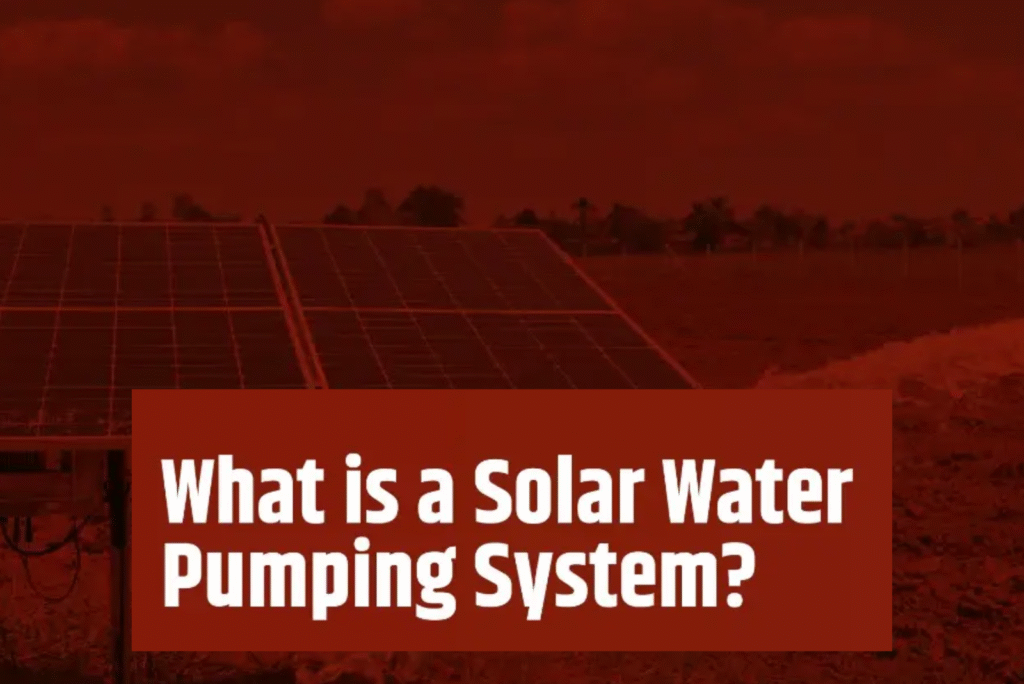
What is a Solar Water Pump? Home Blogs Popular Posts All Posts Blog What is a Solar Water… October 3, 2025 Different Types of Solar Mounting… October 3, 2025 Best Solar Company in Noida:… October 3, 2025 Solar Energy Storage: The Ultimate… October 3, 2025 Power Your Future with KLK Ventures Pvt. Ltd. Delivering reliable solar solutions for a sustainable tomorrow. Switch to clean energy and save with us today. Contact US Solar water pumps are innovatively transforming the way we manage water needs, particularly in remote and rural areas. A solar water pump uses the abundant solar energy to generate power and fetch water from different sources. The perfect use of solar panels to generate electricity is what runs the solar pumps. This method of pumping water is a clean and green solution for all water needs. In this blog, we’ll look into the different aspects of solar water pumps. Are you curious about how they work, all the amazing benefits they offer, the costs involved, and the available government subsidies? Read on. How Do Solar Water Pumps Work? A solar water pumping system is an interesting concept. A solar water pump uses the energy of the sun to fetch water and that is why it is sustainable. Below is the detailed process of the working of a solar water pumping system: 1 Solar Panels Trap Sunlight Photovoltaic panels that are placed in an area with maximum sun exposure absorb the sunlight. Through the photovoltaic effect, the solar cells convert it into electricity. 2. Controller Regulates Power Flow Now that the electricity is generated, it’s sent to a controller. This controller is very useful because it regulates the power flow and makes sure the electricity is delivered in a steady manner to the pump. This makes sure everything works smoothly. 3. Inverter Converts DC to AC (If Necessary) There are two types of pumps that function on current. If a pump is designed to work only on Alternating Current (AC), the DC electricity is sent to an inverter. The inverter converts it into Alternating Current electricity suitable for the pump’s motor. 4. Water Pumping Now the most important function is put to work. The electrically driven pump extracts water from reservoirs, lakes and wells, among other sources. 5. Water Distribution After drawing the water, the solar water pump delivers the water wherever it is needed. The solar water pumping system is also equipped with storage tanks. These are what help maintain a constant supply of water whenever needed, even when the sun’s not shining. Their suspension from the power grid is what makes them an ideal choice for off-grid places. Solar water pumps save money on fuel and electricity and curb carbon emissions. Off-grid solutions such as solar pumps are what the world requires today amidst the energy crisis. Benefits of Using a Solar Water Pump The benefits that a solar water pump offers are many. Below are some of them. Eco-friendly Solution – The use of renewable energy makes them environmentally friendly. The use of such technology helps you move away from polluting sources like fuels or diesel. Cost Savings – There are not many expenses after the initial investment. Solar water pumps need very little maintenance. There will be a great reduction in the fuel costs and you’ll be able to save money in the long run. Ideal for Agriculture – There are many different uses of solar pumps for agricultural purposes. Using them makes it easy for farmers to irrigate their fields and supply water to livestock. Also the government subsidies on the installation of solar water pumps have benefited farmers immensely. Freedom from the Grid – There are numerous locations where electricity is not available. And without power, the world couldn’t function. For water needs, a solar water pumping system comes forth as a boon. It reduces the reliance on grid electricity and other non-renewable sources. Low Operating Costs – A solar water pump has exceptionally low operating costs after it is installed. They turn into a cost-effective long-term solution with no extra costs. Benefits of Solar Mounting Structures The main benefits of having a sturdy solar mounting structure are as follows. Enhanced Stability and Security Your solar panels will have a solid base thanks to a well-designed solar mounting structure. This will guarantee their safety during severe weather. A well-designed system also shields panels from possible harm. Optimal Panel Orientation and Efficiency The Solar module mounting structure also allows for the perfect adjustment of solar panels. This, in turn, maximizes the absorption of sunlight and energy output. Durability and Longevity If you choose high-quality solar mounting structures, you’ll get durability and longevity. These are made to withstand harsh weather and other environmental factors. Space Optimization If there’s an unused space left, the solar structures can be installed there. The solar mounting structures are usually installed on rooftops, carports, or grounds. This also helps when there’s limited space available. Cost Savings Some mounting systems don’t require additional land or expensive work. This makes the installation process very cost-effective. Eco-friendly The solar mounting structures offer the foundation for solar panels which are a clean and green source of energy. By using them you’re contributing to the betterment of the environment too. Installation Process of a Solar Water Pump Step 1 – Analysing Water Requirements It’s important to survey the site before installation takes place to make sure the water demands are met. Finding the right pump size and capacity is one of the advantages of evaluating the water needs. Step 2 – Selecting an appropriate solar water pump Choosing the appropriate solar water pump comes next after determining your water requirements. There are different types of pumps on the market from which to choose. Pick the one that fits your requirements well for better efficiency. The options are – Submersible Solar Water Pumps Surface Solar Water Pumps DC Solar Water Pumps AC Solar Water Pumps Step 3 – Installing the Solar Panels Solar panels are what help run the solar pumps. These panels must be installed correctly to absorb sunlight properly. Select the right one from the different
Different Types of Solar Mounting Structures
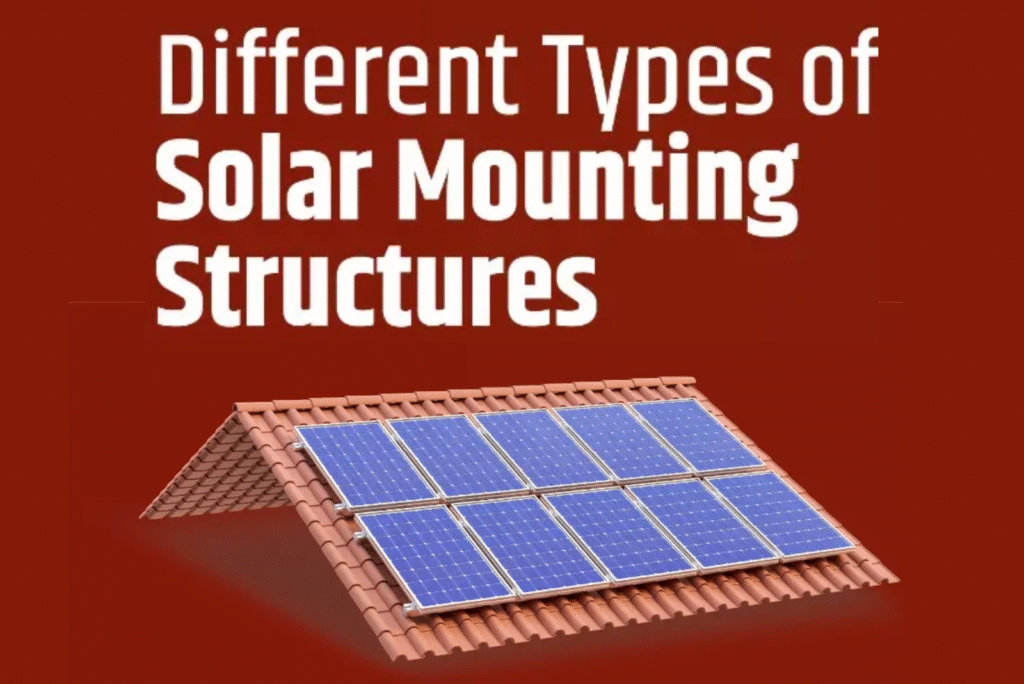
Different Types of Solar Mounting Structures Home Blogs Popular Posts All Posts Blog Different Types of Solar Mounting… October 3, 2025 Best Solar Company in Noida:… October 3, 2025 Solar Energy Storage: The Ultimate… October 3, 2025 How Photovoltaic Panels Create Power October 3, 2025 Power Your Future with KLK Ventures Pvt. Ltd. Delivering reliable solar solutions for a sustainable tomorrow. Switch to clean energy and save with us today. Contact US Are you thinking of installing solar panels? Many people are considering the same thing, so you’re not alone. As more and more people switch to solar power, the use of solar energy for good has gone up immensely. There are many reasons why solar panels are beneficial, but what specifically makes them better? The solar mounting structure. It is the most crucial factor to take into consideration. The solar structure is the foundation of your solar panels. These structures ensure the security and proper functioning of your panels. So, for the same reason, getting the right solar mounting structure is vital. Are you just starting out? Or are you thinking of upgrading your system? Worry not, this guide will help you out. What Is a Solar Mounting Structure? Let’s start with learning what a solar mounting structure is. It’s utilized to safely mount rooftop solar panels or on the ground. These solar structures provide stability and security so that the panels remain stationary and operate efficiently under any weather conditions. The optimal solar mounting systems are what individuals installing solar panels require for enhanced efficiency and the lifespan of the solar system. Types of Solar Mounting Structures 1. Roof Mounting Structure These solar mounting structures are used when you need to install solar panels on concrete rooftops. These are the solar module mounting structures that you’ll find mostly everywhere. Because they are generally compact and space-saving, they are used in buildings or homes with a very limited amount of space. You can install these solar structures on both sloped and flat roofs. Why Choose Roof Solar Mounting Structures? Space-saving Cost-effective Maximum sun exposure 2. Ground Mounted Solar Structures If you’re capable of covering extensive areas, ground mounted solar structures are most likely to be the most suitable option for you. Since these structures are placed on the ground, you would have flexibility along with greater energy output. Why Choose Ground Mounted Solar Structures? Flexibility More accessibility Better energy efficiency 3. Pole Mounted Solar Structures These solar structures are installed on poles that are fixed on the ground. You’ll find two options for the same, top poles and side poles. The size of the solar panels determines the number of poles the system can be installed on. Why Choose Pole Solar Mounting Structures? Elevated Positioning Increased Security Adjustable Options 4. Solar Carports What could be better than getting dual benefits? The type of solar mounting structures offers covered parking space while also generating solar power. You can consider this as an option if you have limited space. Why Choose Solar Carports? Saves Space Offers shades for vehicles High energy output 5. Tracking System Mounting Structure The tracking system mounting solar structures is innovative and efficient. These structures automatically adjust the position of the solar system’s panels to track the sunlight and capture it properly. There are two types of tracking systems – Single-Axis Trackers and Dual-Axis Trackers. Why Choose Tracking Mounting Structure? Higher Energy Production Maximized Efficiency Better ROI 6. Shed Mounting Structure Shed mounting structures are just like rooftop mounted solar structures. The only difference is that instead of concrete, they are installed on metal sheds or sheet roofing. This is a great option for business owners as it’ll help them create their own green and clean energy. Why Choose a Shed Mounting Structure Easy Maintenance Low Installation Cost High Energy Output Benefits of Solar Mounting Structures The main benefits of having a sturdy solar mounting structure are as follows. Enhanced Stability and Security Your solar panels will have a solid base thanks to a well-designed solar mounting structure. This will guarantee their safety during severe weather. A well-designed system also shields panels from possible harm. Optimal Panel Orientation and Efficiency The Solar module mounting structure also allows for the perfect adjustment of solar panels. This, in turn, maximizes the absorption of sunlight and energy output. Durability and Longevity If you choose high-quality solar mounting structures, you’ll get durability and longevity. These are made to withstand harsh weather and other environmental factors. Space Optimization If there’s an unused space left, the solar structures can be installed there. The solar mounting structures are usually installed on rooftops, carports, or grounds. This also helps when there’s limited space available. Cost Savings Some mounting systems don’t require additional land or expensive work. This makes the installation process very cost-effective. Eco-friendly The solar mounting structures offer the foundation for solar panels which are a clean and green source of energy. By using them you’re contributing to the betterment of the environment too. Things to Consider Before Choosing Solar Mounting Structure 1. Available Space Roof space – If your roof space is limited, go for a roof mounted solar structure. Ground space – If your property has ample land, ground mounted solar mounting structure offers several benefits that include flexibility and energy maximization. 2. Climate and Weather Conditions For windy areas, you should consider a sturdy mounting structure, like ground mounted or pole systems. For snowy regions, you’ll find that pole mounting structures are the best. As there won’t be any snow accumulation or interference with the capturing of sunlight. For areas that experience high rainfall, structures like rooftop mounted systems are the best. 3. Maintenance Requirements Regular maintenance services are necessary for the proper working of a solar panel system. So, consider this aspect too before you choose. Choose a system that you find easy to maintain, for example, ground mounting systems are generally easier to maintain. 4. Structural Integrity and Durability The solar mounting structures should be made from durable materials that can
Best Solar Company in Noida: Powering Your Future with Clean Energy
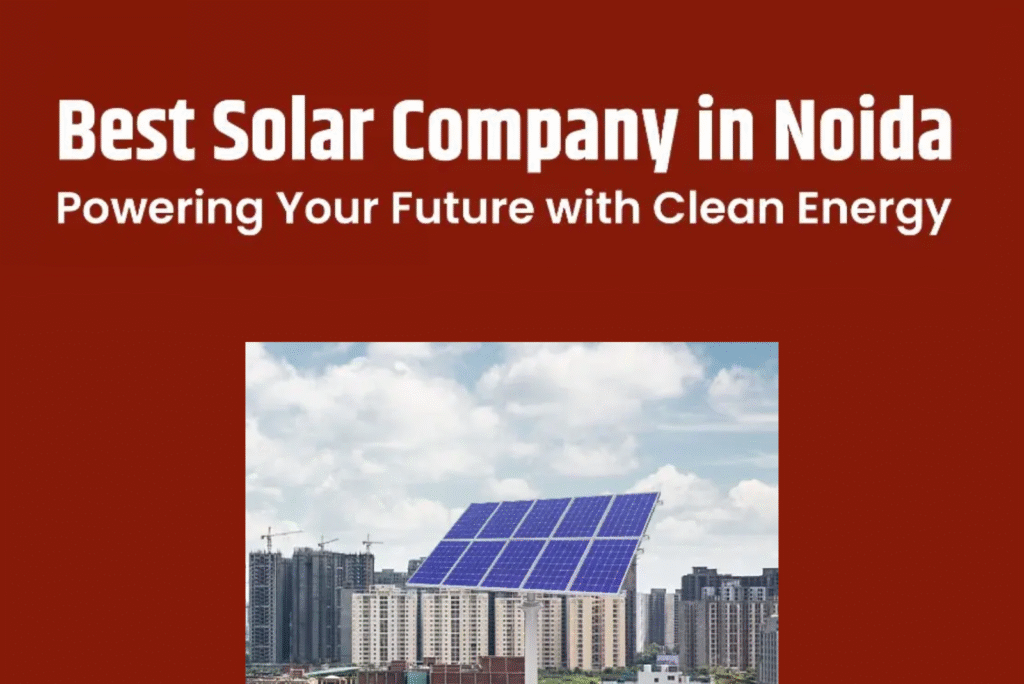
Best Solar Company in Noida: Powering Your Future with Clean Energy Home Blogs Popular Posts All Posts Blog Best Solar Company in Noida:… October 3, 2025 Solar Energy Storage: The Ultimate… October 3, 2025 How Photovoltaic Panels Create Power October 3, 2025 Best Guide to the Different… October 3, 2025 Power Your Future with KLK Ventures Pvt. Ltd. Delivering reliable solar solutions for a sustainable tomorrow. Switch to clean energy and save with us today. Contact US Looking for a reliable solar company in Noida? You’re in the right place. At KLK Ventures, we are devoted to helping people with energy solutions that are beneficial for the environment as well. With the growing energy crisis, we understand that your attention must have shifted towards renewable resources of energy. The Sun is one such prominent source of energy. KLK Ventures, being the best solar company in Noida, provides effective solar solutions that make the best use of solar energy. Solar Services We Offer 1. Solar Water Pumping System Solar water pumping systems have changed the way people access water. As one of the best solar company in Noida, we strive to provide innovative solar water solutions for agriculture, households, and industrial applications. Replacing conventional solar pumps with advanced solar water pumps will be cost-effective in the long run. They will contribute to the betterment of the environment as well. 2. Commercial Solar System Commercial solar systems are large-scale energy solutions designed for businesses and industries. There’s a lot of energy consumption in businesses and industries which can negatively impact the environment and also prove to be very costly. As the best solar manufacturers in Noida, we understand your concern and offer the best and most cost-effective commercial solar solutions. 3. Off-grid Solar System Our off-grid solar systems provide energy independence which is suitable for rural areas or off-grid homes. As the best solar panel company in Noida, we offer top-notch off-grid solar systems that generate power and store the excess in batteries. The battery storage makes these systems very reliable and cost-effective. 4. On-grid Solar System On-grid systems provide a reliable and economical energy solution by connecting to the main power grid. We offer on-grid solutions that allow homeowners and businesses to make use of solar energy while staying connected to the grid. The excess energy can be sent back to the grid allowing users the benefits of net metering. 5. Solar Lighting System Solar lighting systems are eco-friendly and innovative energy solutions for residential and commercial areas. We offer solar lighting that replaces conventional electricity sources using solar power. These systems are beneficial for the environment and reduce energy consumption too. 6. Solar Annual Maintenance Contract Maintenance of solar panel systems is essential to maximize solar performance. Our Annual Maintenance Contract services ensure the longevity and efficiency of your solar systems through inspections, cleaning, repairs, and proactive maintenance. You’ll enjoy hassle-free operations to keep your solar systems running at their peak. Why Choose KLK – The Best Solar Panel Company in Noida? Our main focus is on providing the best quality solar panels with high efficiency. Being the best solar panels company in Noida, we ensure our every solar product is best in all aspects. By choosing KLK Ventures, you’re not just investing in solar panels, but in a future of sustainable, eco-friendly energy. Here’s why we stand out: Top-Quality Products: We supply only the best solar panels. To ensure the best outcomes, these panels are tailored to your requirements! Economical Solutions: The purpose of solar panels is to be economical. By selecting the best energy source available, we help you in lowering your bills. It’s an investment worth making. Expert Consultation: Our team of experts will take care of your requirements and smoothen the entire process for you. Your system will be optimised for excellent performance.
Solar Energy Storage: The Ultimate Guide
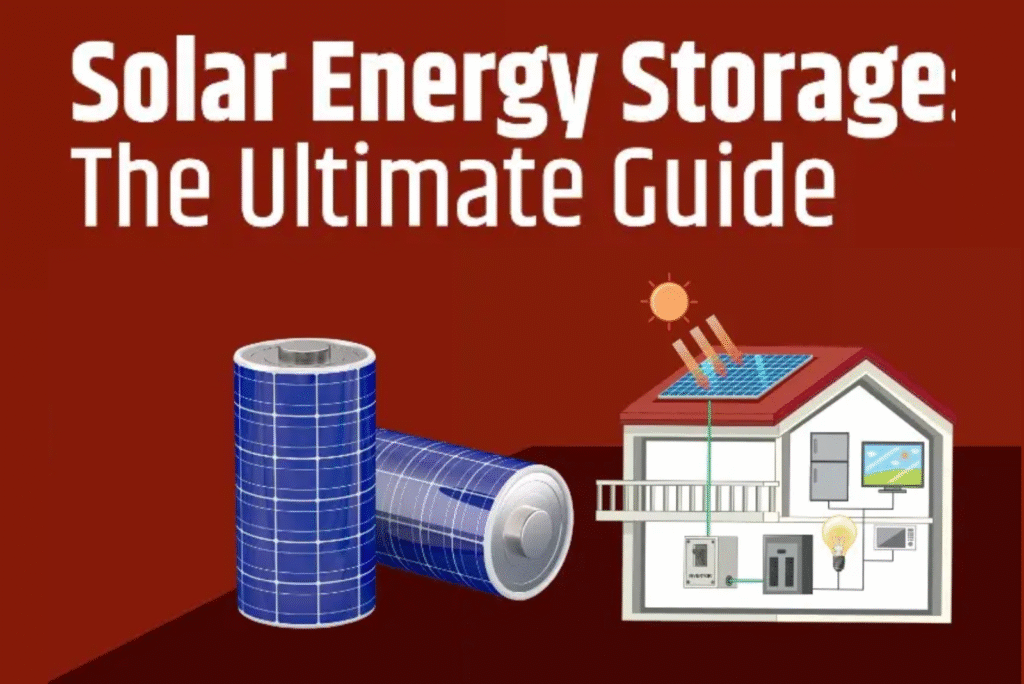
Solar Energy Storage: The Ultimate Guide Home Blogs Popular Posts All Posts Blog Solar Energy Storage: The Ultimate… October 3, 2025 How Photovoltaic Panels Create Power October 3, 2025 Best Guide to the Different… October 3, 2025 How Does Solar Power Work? October 3, 2025 Power Your Future with KLK Ventures Pvt. Ltd. Delivering reliable solar solutions for a sustainable tomorrow. Switch to clean energy and save with us today. Contact US The world is facing an energy crisis, leading everybody to renewable energy sources. One such wonderful source is solar energy which offers a very energy-efficient and sustainable solution. You already know the mechanism behind the proper use of solar energy. Solar panels harness the sun’s energy and convert it into heat or electricity. Now the thing is, photovoltaic panels only create power when the sun is shining so that’s where solar energy storage comes into the picture. These systems store the energy for later use. Now the question is how does solar energy storage work? Let’s find out! What is Solar Energy Storage? During the nighttime the power demand is high, but as the sun is not shining, the solar panels don’t work. That’s where solar energy storage helps power buildings or homes. It is the process of storing excess electricity in different types of solar batteries. Solar energy storage doesn’t just mean battery storage, there’s more to it. Let’s read on. How is Solar Energy Stored? There are three ways to store solar energy – Battery, Thermal, and Mechanical. These systems work differently to store energy, let’s read to know how. Battery Storage This system is the most common type used to store solar power. You’ll find batteries mainly connected to off-grid solar power systems. The process of energy storage involves the batteries converting electricity into chemical energy. The chemical energy is then converted back into electricity when required. The different types of solar batteries are: Lithium-ion Batteries: These batteries are a common option for home applications. And are remarkable because of their high energy density, small size, and longevity. Besides all of that, you will find that they function well despite their price. Lead-acid Batteries: While they are slightly older than lithium-ion batteries, lead-acid batteries remain appreciated for their low cost. The downside is that they can weigh a lot and have low energy density. Flow Batteries: These batteries are a result of innovation, they use liquid electrolytes to store energy. Flow battery storage can be a little expensive due to their innovative technology. 2. Thermal Storage In thermal energy storage (TES) systems, solar energy gets stored in the form of heat. Solar panels capture the sunlight and convert it into heat. The same heat is stored in various mediums such as water or molten salts. These mediums absorb and retain heat for a long, long time. Also, an insulated tank is used to store the heated mediums and are kept there until it’s time to use the energy. The most common form of thermal storage is molten salt storage. 3. Mechanical Storage Mechanical storage systems store solar energy in the form of kinetic or potential energy. This is later converted back to electrical energy. There are two main types of mechanical storage. One is pumped hydro system storage, the most widely used type of energy storage. This system pumps water from a lower reservoir to an upper reservoir using solar energy to store potential energy. The water is released to flow back through turbines to electricity when needed. Second is flywheel storage, a technology that uses a rotating mechanism to maintain rotational energy. The flywheel is accelerated by large amounts of solar energy and when the power is demanded, the flywheel slows down and transforms the kinetic energy back into electrical energy. What are the Benefits of Solar Energy Storage? There are so many reasons as to why storing solar energy is useful. Below are listed a few. Balanced Energy Loads – Do you know what will happen without storage? The excess energy produced by the panels will go to waste. By installing battery storage, you’ll be helping balance energy loads. These storage systems can store energy during low demands and use it during high demands. Emergency Backup – What would you do during a sudden power cut or bad weather? In such times the electricity grid can fail, so that’s where the solar energy storage comes into use. The storage systems have backup power to ensure that you won’t be left in the dark. Lowered Electricity Bills – Choosing an efficient solar storage system will store extra energy for you and you won’t have to worry about using the electricity grid. You’ll reduce your bills in this way by relying on the storage when necessary. Reduced Carbon Footprints – The conventional sources of energy are responsible for all the pollution and harm to the environment. You’re not only doing good for yourself but also the environment by going solar. A solar system with energy storage will help you use clean power thus reducing carbon emissions. Energy Independence – There are so many places where frequent power outages occur, and where the electricity grid is not an economical option. Such places benefit greatly from solar systems with solar energy storage. The stored green energy helps power homes and appliances in remote areas. Factors to Consider When Choosing Solar Energy Storage Storage Capacity – You have to consider your energy needs when picking a solar energy storage system. If your home or business demands high power, then go for systems with large storage capacity. This will help you power your home or office smoothly. Battery Life – Solar batteries tend to last 10 to 15 years with proper maintenance. Who doesn’t want a durable battery? Selecting high-efficiency solar batteries with a strong warranty is necessary for the best performance. System Integration – You should think about system integration if you intend to add to your current solar system with solar energy storage. For increased efficiency, make sure your battery system and inverter are compatible. Conclusion We all can
How Photovoltaic Panels Create Power
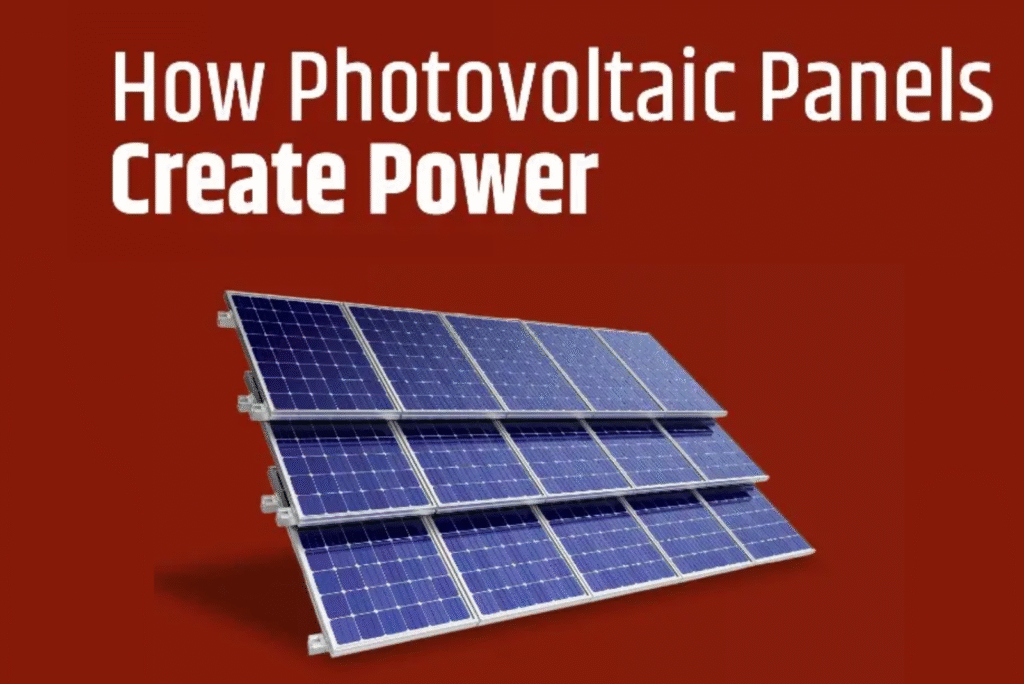
How Photovoltaic Panels Create Power Home Blogs Popular Posts All Posts Blog How Photovoltaic Panels Create Power October 3, 2025 Best Guide to the Different… October 3, 2025 How Does Solar Power Work? October 3, 2025 Cells, Modules, Panels and Arrays October 3, 2025 Power Your Future with KLK Ventures Pvt. Ltd. Delivering reliable solar solutions for a sustainable tomorrow. Switch to clean energy and save with us today. Contact US Who would have believed that it would be this easy to utilize the energy of sunlight to generate electricity? Technology has been leading the world towards sustainability. Thanks to it, we now have amazing solar panels. These panels use the sunlight in the best possible way, which also helps the environment. You already know that solar power helps in heating water, cooking, and heating & cooling with the help of solar panels. But when it comes to electricity generation, photovoltaic panels enter the picture. These incredible pieces of technology are very effective in generating energy for our daily use. It’s obvious that you now think about how these panels actually create electricity. The seemingly magical phenomenon is aided by these photovoltaic panels or solar panels. Below in the blog, we will go into detail about it. One thing to note is that solar panels is a generic term that refers to all kinds of panels, like solar thermal panels or PV panels. So, yes, there’s a slight difference between solar panels and photovoltaic panels. What are Photovoltaic Panels? Photovoltaic panels can be called the heart of this whole system. This is the site of energy conversion, from the sun’s rays to electricity running the appliances in your homes. These PV panels are constructed of many solar cells put together. These solar cells are made of a semiconductor material that is responsible for the whole functioning. These cells generate electricity in a manner that is efficient and non-damaging to the environment. What are the Key Components of Photovoltaic Panels Solar Cells Solar cells are one of the most important components in a PV panel. These cells are responsible for the energy conversion. Usually made of silicon, they soak up the sunlight during the daytime. This generates an electric current. A PV panel contains many cells; it all depends on the size of the panel. To know more about them, read: How do solar cells work? Glass cover These panels need to be out in the open to collect the sunlight. This puts them at great risk of rain or damage from the extreme weather. So, we have a glass cover to protect them from any kind of damage without hampering the sunlight absorption. Frame As these panels go up on the rooftops and other structures, they need a support system to mount them safely. These frames are often made from aluminium and provide structural support. Backsheet The solar cells require protection from moisture and other environmental factors. The backsheet at the rear also provides insulation. Junction Box The junction box allows the current to flow out of the panels and into the inverter. Where the current is converted to usable electricity. Now that you know about the components of a photovoltaic panel, let’s look at how solar panels work. How do PV Panels Generate Electricity? You know what photovoltaic panels are by now. Now, the question is, how do these PV panels work to create power? The process of this is called the photovoltaic effect. Let’s learn about it step by step. 1. Sunlight Strikes the Solar Panel The process begins as soon as the installed solar panels come into contact with sunlight. The small packets of energy carried through the sun’s rays strike these panels. Cells, made of silicon, a semiconductor material, then interact with these photons. 2. Photons react with Electrons As soon as the photons react with the electrons in the solar cells, the energy is transferred to them. They get excited, and this causes a movement. Electrons, then, break free to move in a single direction. 3. Electrons Move in One Direction Solar cells made of silicon have two layers present in them; one side is positively charged, and the other is negatively charged. The electric field created due to this pushes the electrons to move in one single direction. Their movement generates an electric current. 4. Electric Current is Generated When the electrons move out of the photovoltaic panels and into an external circuit, the flow creates an electric current. This current is direct current (DC) electricity. 5. Direct Current is Converted The direct current electricity that is generated is usually not used by homes and appliances. So, to make the electricity good for use, an inverter converts it into Alternating Current (AC) electricity. 6. The Use and Storage of Power The AC electricity is used to power the appliances and homes. But solar panels produce electricity in large quantities, which cannot be utilized all at once. That is where on-grid and off-grid solar power systems help you out. The On-grid solar system returns the electricity to the grid (this makes you enjoy the benefit of net metering). An off-grid solar system comes with a battery backup to save electricity for future use. Why Should You Use Photovoltaic Panels? PV panels are one of the most significant systems of generating sustainable, renewable and cleaner energy. They conveniently transform the sunlight into usable electricity. What’s better than using power that doesn’t harm you and the environment? Many other advantages are accompanied by Photovoltaic Panels. No Pollution Solar Energy does not degrade the land and misuse water like other traditional power plants. They do not harm the environment. Sustainable Energy The production of electricity by solar panels leads to the emission of clean and greener energy. It is a renewable resource which limits the use of depleting resources like the fossil fuels. Great Life Span Solar panels, once installed, do not require any extraneous or heavy maintenance, just occasional cleaning and very minimal maintenance. Reduced Electricity Bills The Installation of solar
Best Guide to the Different Types of Solar Water Pumps
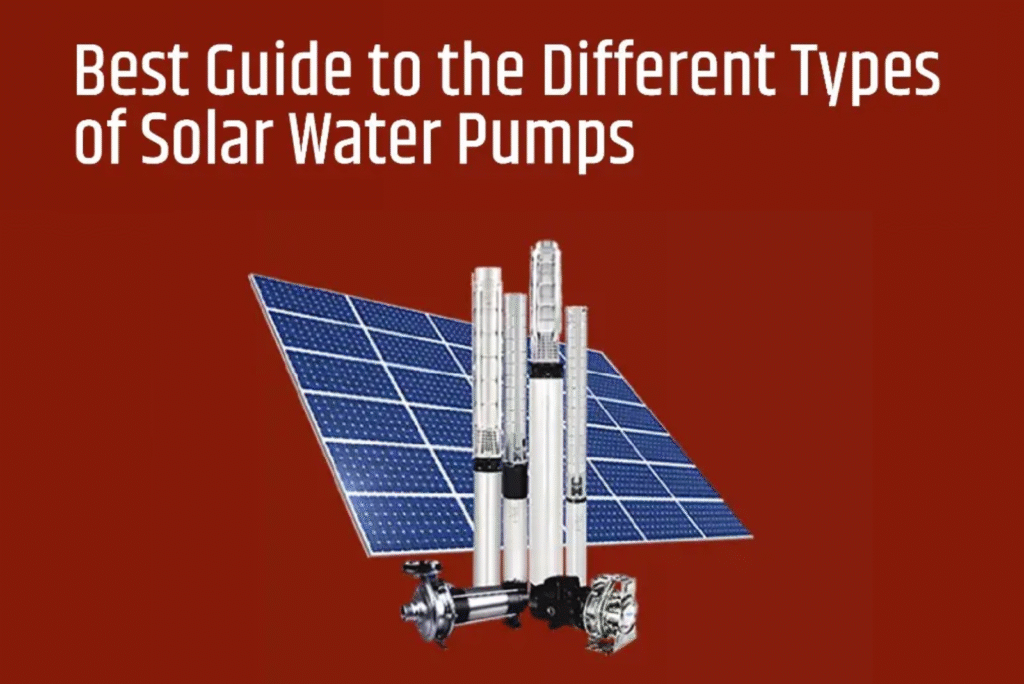
Best Guide to the Different Types of Solar Water Pumps Home Blogs Popular Posts All Posts Blog Best Guide to the Different… October 3, 2025 How Does Solar Power Work? October 3, 2025 Cells, Modules, Panels and Arrays October 3, 2025 The Positive and Negative Environmental… October 3, 2025 Power Your Future with KLK Ventures Pvt. Ltd. Delivering reliable solar solutions for a sustainable tomorrow. Switch to clean energy and save with us today. Contact US Solar energy can be utilized in numerous different ways, and each one will benefit all of us. A solar water pumping system is one way. Solar water pumps are revolutionizing things! You might ask why. Not only are they cost-effective, but they are also environmentally friendly. People use these pumps for different purposes, for example, gardening and farming to domestic uses. Because there are different types of solar water pumps, people may get confused about choosing the right one. This blog is going to take you through various solar water pump types and uses and assist you in making the right choice. What is a Solar Water Pump? It’s important to know what a solar pump is before we move on to the different types of solar water pumps. As you already know, these pumps are driven by solar power. The solar water pumping systems come with solar panels that help in converting sunlight into electricity. The same electricity is used to power the pumps. Solar water pumps are excellent for places with no electricity or if there are power outages every now and then. Since instead of using the utility grid, one can just install solar pumps and reduce electricity bills. Not only that, but they will benefit the environment in the long term due to the use of green energy. These solar pumping systems are an affordable means of assisting in the reduction of carbon footprints without hindering the efficient functioning of water systems. How Solar Water Pumps Work? 1. Solar Panels Capture Sunlight Solar panels are placed where sunlight is plentiful. This allows it to be simple for solar panels to absorb the sunlight and use it to produce electricity using the photovoltaic effect. 2. Powering the Pump The electrical energy that gets produced by the photovoltaic panels is then used to power the pump’s motor. The motor starts and moves the water. 3. Water Movement After the solar water pump gets powered by electricity, it draws the water from wells, ponds, or reservoirs to where it is required. These solar water pumps for agriculture are amazing because they assist the fields in receiving the required water. 4. Energy Storage Some solar water pumping systems come with solar energy storage. The batteries help store the energy for times when the sun is unavailable or there are any power issues. The energy storage keeps the pumps running. What are the Different Types of Solar Water Pumps? Now that we know what solar water pumps are, let’s move on to their types. Based on Function 1. Submersible Solar Water Pumps Submersible solar pumps are designed to be installed below the ground level, straight in the water source. Submersible pumps work on solar panels that harness the sun’s energy for electricity. The same electricity is utilized in powering the pump’s water. Since these pumps are submersible, they can obtain water sources at even great depths. Submersible pumps prove beneficial in areas where grid electricity is costly and commonly absent. Advantages of Submersible Solar Pumps They work effectively in deep wells where other pumps might not reach. They are low maintenance as they have a sealed design. These pumps are very cost-effective compared to conventional ones. 2. Surface Solar Water Pumps As the name itself indicates, surface solar pumps operate on the water’s surface, abstracting water from wells, rivers, or lakes. These too operate using the energy of the sun. Surface solar water pumps are extremely useful! Surface solar water pumps may also be used for domestic water supply or community water supplies. Advantages of Surface Solar Water Pumps These pumps are easy to install and maintain as they are installed on the surface. Surface solar pumps are great for drawing water from shallow lakes and rivers. These pumps are really energy efficient and environmentally friendly. Based on Current 1. AC Solar Pumps The AC solar water pumping system is based on alternating current (AC). The pumps are excellent for regions with high flow rates and higher water pressure. Solar pumps are utilised for large systems such as agriculture. The introduction of AC solar water pump for agriculture has made irrigating fields easier. Advantages of AC solar water pumps They are best designed for applications with high requirements that require high-pressure flow. AC solar pumps offer a reliable solution for the mass pumping of water. The pumps are best suited for operations that demand persistent performance. 2. DC solar Pumps The DC solar water pump works on direct current (DC). These solar water pumps are great for places where low pressure is required. People can install Direct Current solar pumps for smaller scale applications like livestock watering, home uses or garden fountains. And the best part about them is that they are cost-effective and eco friendly. Advantages of DC Solar Water Pumps These pumps are suitable for small applications and are highly energy efficient. DC solar pumps are suitable where there is no reliable grid power. These pumps are also very cost-effective. What are the Applications of Solar Water Pumping Systems? 1. Agricultural Irrigation There’s a great use of solar water pumps for agriculture. The fields are generally located at remote places where the utility grid is not a good source of electricity. Some areas in remote locations face frequent power outages and poor electricity supply. These solar water pumps can prove to be really beneficial in supplying water to such areas. For farmers, solar water pump for agriculture are extremely useful as large fields require a constant water supply. The utility grid can be really
How Does Solar Power Work?
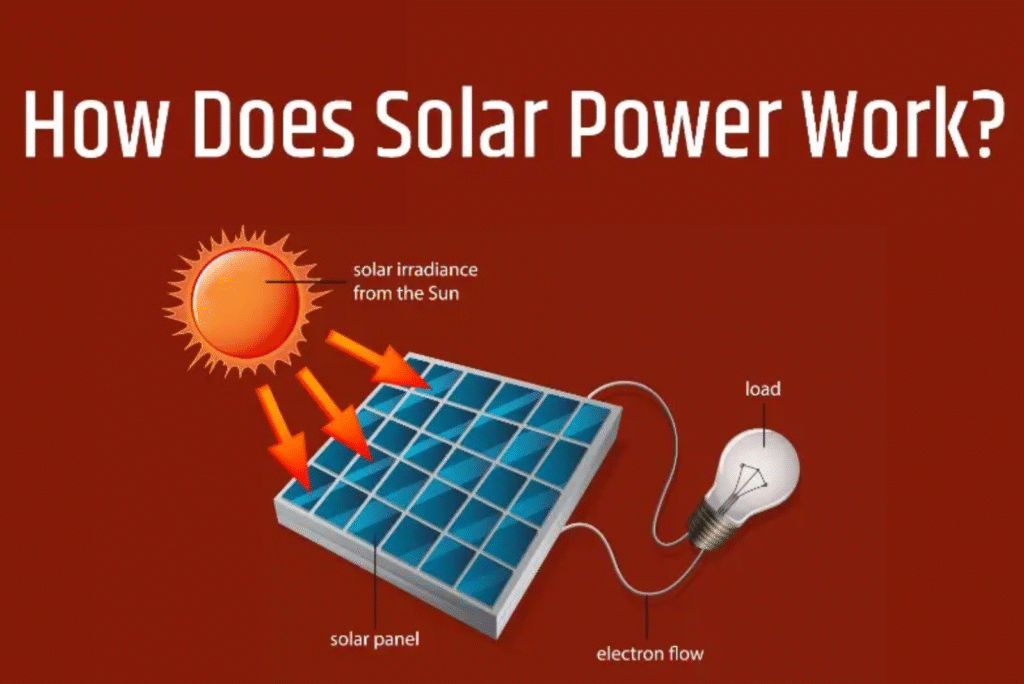
How Does Solar Power Work? Home Blogs Popular Posts All Posts Blog Seasonal Maintenance Tips for Solar… October 6, 2025 Solar Water Pump vs Regular… October 6, 2025 Rooftop Solar vs Ground-Mounted Solar October 6, 2025 Choosing the Best Solar Panel… October 6, 2025 Power Your Future with KLK Ventures Pvt. Ltd. Delivering reliable solar solutions for a sustainable tomorrow. Switch to clean energy and save with us today. Contact US The sun is the ultimate source of energy that generates heat and light in unlimited amounts. This energy of the sun can be used to produce electricity. Solar power is the most efficient and renewable energy resource for producing electricity. Unlike fossil fuels and other conventional forms of energy, a solar power system contributes towards green and cleaner energy. If you are considering becoming energy independent, KLK Ventures should be your first choice to trust for the best solar solutions. Before planning to bring this solar power into your home, you should know how it works. The present blog is the ultimate guide which will help you to understand solar power technology. The step-by-step process is explained below, along with the answers to key questions. What is Solar Power? Solar power refers to the power of the sun harnessed by solar panels for heating purposes or electricity generation. The production of electricity or heat is greenhouse gas-free and also low in cost. This means that by going solar not only are you availing benefits but the climate is also benefiting. There are two main types of solar power technologies: 1. Solar Photovoltaic (PV): PV panels harness the energy from sunlight to produce electricity through the photovoltaic effect. PV panels are generally installed on roofs or solar farms. 2. Solar Thermal Energy: This is the process of using sunlight to create heat. The systems are employed for the heating of water, air, and other substances for use in home heating, hot water, or even industrial applications. Now let us understand the mechanism of solar panels through which the energy is produced. How do Solar Panels Work? Solar panels for homes function by receiving the sun’s rays and changing them into electricity or heat. They are of various sizes ranging from small to big for applications in commercial use or small lands. The most crucial part is the photovoltaic cells. The cells are constructed using semiconducting material such as silicon. The rays of the sun hit solar panels. This is absorbed by the solar cells. The particles of light are made up of photons. The sun’s rays fall on solar panels. This is absorbed by the solar cells. The particles of light are made up of photons. These photons excite the electrons in the material. This generates the electric charge. The electric charge leads to the flow of electrons which generates direct current (DC). The DC electricity generated is converted to the alternating current (AC) by passing through an inverter. This electricity is suitable for home usage. Different Types of Solar Power Systems There are various types of solar power systems, among which three are on-grid, off-grid and hybrid solar systems. Once you decide to go solar, the first thing is to choose the system that suits you the most. Grid-tie systems This saves money on your electricity bills. It is far less expensive than the electricity brought from utility companies. This system is connected to the electricity grid. The excess electricity can also be transferred back to the grid. When the solar power is not working, you can harness power from the same grid. Off-grid systems This system is independent of the electricity grid. It is used to deliver power to remote areas with no access to power lines. These systems come with different types of batteries attached; the batteries store power for later use. They are more costly when compared to grid-tie systems. Hybrid systems Apart from the above two, there is also a third system which is a hybrid of these two. This system is connected to the grid but also uses batteries. You can use these in times of power cuts and low sunlight. Because of this, hybrid solar systems are more reliable as they have both the properties of grid-tied and off-grid solar power systems. How long do Solar Panels work? Although solar panels last for many years without any difficulty, their working also depends on the manufacturers. Most of them guarantee the efficiency of working for more than 25 years. Even after the warranty is up, the panels keep on working with low efficiency. Parts like inverters and batteries have a short life span and you need to replace them at least once. With KLK Ventures, you need not worry about the efficiency of your solar panels for home. We provide our customers with the best and most efficient products. Applications of Solar Power 1. Residences Residential solar panels are increasingly in use for house rooftops. They provide electricity and hot water to homes. Their installation also increases the value of homes. 2. Corporate Areas Many small and big businesses use solar panels to reduce the cost of electricity or improve sustainability. The excess electricity can also be sold, generating more income. 3. Agriculture Solar Power is also used in agricultural settings. For example, in irrigation systems, lighting, etc. 4. Remote Locations The remote areas with no access to the grid depend on solar power (off-grid system) for generating electricity. Top 5 Advantages of Solar Power 1. Renewable Means of EnergySolar power is a top priority in residential or commercial uses due to the production of renewable forms of energy. This power is harnessed by capturing the energy of the sun. Sun is that form of light resource which will never deplete like the fossil fuels. Therefore, by going solar, you will become energy-independent. 2. Reduction in Electricity Bills With the help of solar energy, you can produce your own energy. By doing so, you can become independent of the electricity grid. Ultimately, this will cause a reduction in electricity bills. 3.
Cells, Modules, Panels and Arrays
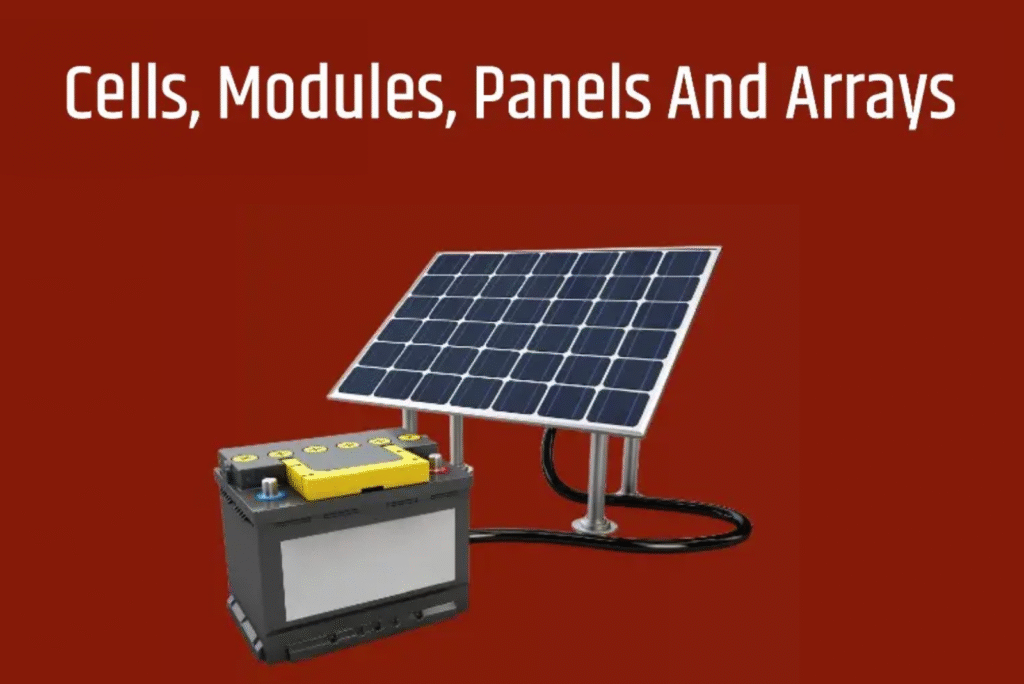
Cells, Modules, Panels and Arrays Home Blogs Popular Posts All Posts Blog Seasonal Maintenance Tips for Solar… October 6, 2025 Solar Water Pump vs Regular… October 6, 2025 Rooftop Solar vs Ground-Mounted Solar October 6, 2025 Choosing the Best Solar Panel… October 6, 2025 Power Your Future with KLK Ventures Pvt. Ltd. Delivering reliable solar solutions for a sustainable tomorrow. Switch to clean energy and save with us today. Contact US Solar power has been in continued use over recent years. Solar energy is prioritized over other forms of fossil fuels or non-renewable sources of energy. It is because of the clean and green energy which is produced from this method. Besides being environment friendly, it also benefits the home makers and individuals. Solar energy is cost-effective, depending only on the reliability of the energy of the sun. The installation of a solar power system on the rooftop of your house is a complex process. However, with KLK Ventures, you need to be free of any worries. The management and installation process becomes easier by trusting the efficient team members. Before you begin the process of installing a solar system, it is necessary that you know how the system works. This will help you in selecting the best and efficient system for yourself. The present blog will explain to you how solar power works by explaining the difference between solar cells, modules, panels and arrays. What is a Solar Cell? A solar cell is the primary component needed for the construction of a solar panel. It converts the energy of the sun from light to electricity cells. These are also known as photovoltaic cells and work by generating electricity. Solar cells are generally made of silicon, a semiconductor. These cells alone cannot generate enough power for consumption, so they are interconnected to form a module or a panel. There are different solar cell types used for their distinct purposes and applications. They are monocrystalline, polycrystalline, thin-film and perovskite solar cells. How do Solar Cells Work? Solar cells are generally made up of two layers of silicon, which is a semiconductor material. The two sides create an electric field. When the sunlight hits the surface of solar cells, photons react with the electrons in the solar cells and cause a movement in them. This movement helps in generating an electric current. To know more about the process, along with other details, you can read about solar photovoltaic cells. What are the Advantages of Solar Cells? Solar cells are very efficient depending upon the material type, cell quality and environmental conditions. These cells also help increase the efficiency of your system. They also help create green energy, which has made solar energy more popular over recent years. What is a Solar module? Solar modules and solar panels are names often used interchangeably. A solar module is an individual solar panel or a collection of interconnected solar cells. Solar cells, as we know, are employed to produce electricity. When they combine to form a module or array, it is used to supply extensive power to buildings. A solar module has higher efficiency and power output than solar cells. This leads to more energy production. Solar modules are used for purposes like commercial buildings and homes. These are what makes energy generation in good amounts possible. More cells mean more sunlight absorption! 4 Key Advantages of Solar Modules These modules are highly efficient. Durable enough to withstand adverse weather conditions They are light in weight and easy to install. They are also cost effective. What are Solar Panels? Solar panels are what we call innovative devices made with a combination of two or more solar modules. One solar module is not enough to supply the entire house, so we have to assemble them together in the form of larger solar panels. These panels help in converting sunlight into electricity or simply trap the heat just like any solar module. Solar Panels consist of multiple solar cells, which consist of silicon. It generates the direct current (DC), which should be transformed into alternating current (AC) in order to be used in homes. What are the Advantages of Solar Panels? Solar panels produce clean and green energy Often requires very little maintenance It is independent of other sources of energy. It also leads to a reduction in Electricity bills. There are many other reasons why solar panels are beneficial. You can install them to get the most benefits and help the environment as well. What is a Solar Array? A solar array is a collection of solar panels or modules and is helpful in generating large amounts of electricity. The installation of a solar array and the number of solar panels required for it depend on various factors – the purpose and the electricity consumption rate. As the panels are stringed together, the wires are connected into one main output, this helps in easier connection to the solar inverter. 4 Key Advantages of Solar arrays It allows greater power generation. Initial investment may seem higher, but in the long run they prove to be really beneficial and cost effective. Useful for both residential and commercial areas. Solar arrays are very environmentally friendly and sustainable. They produce clean energy without contributing to pollution. Conclusion Solar cells, modules, panels and arrays are all important for a solar power system to function well. They all have distinct features and purposes, which makes you understand properly the installation of a solar system. It might seem to be complex at first. However, when you understand it by breaking it into smaller parts, they are very simple. KLK Ventures makes this installation process even easier. Our skilled professionals will assist you in the installation and subsequent management of the system. Solar power is the need for the future of green energy. Be a part of creating an environmentally friendly world by taking advantage of solar power systems. FAQs 1. What is the average lifespan of solar panels?Solar panels have a lifespan of 25 to 30 years. The efficiency decreases with
The Positive and Negative Environmental Impacts of Solar Panels
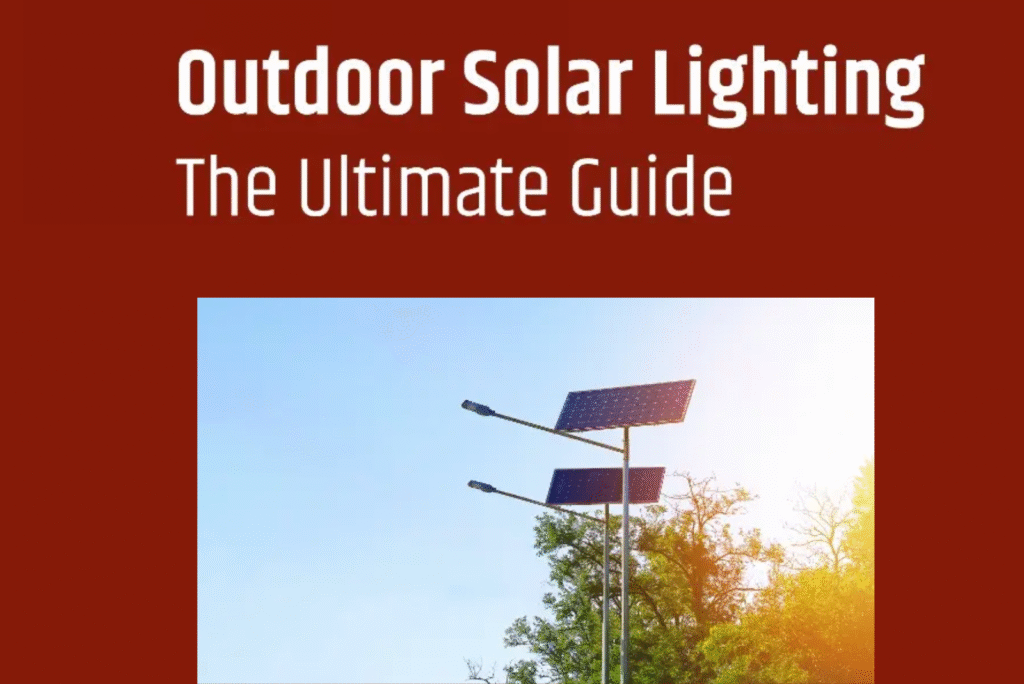
The Positive and Negative Environmental Impacts of Solar Panels Home Blogs Popular Posts All Posts Blog Seasonal Maintenance Tips for Solar… October 6, 2025 Solar Water Pump vs Regular… October 6, 2025 Rooftop Solar vs Ground-Mounted Solar October 6, 2025 Choosing the Best Solar Panel… October 6, 2025 Power Your Future with KLK Ventures Pvt. Ltd. Delivering reliable solar solutions for a sustainable tomorrow. Switch to clean energy and save with us today. Contact US Solar panels have become the trend and a very feasible one at that. Not only are they a reliable source of energy, but they are also very clean and sustainable. Solar panels play an important role in reducing carbon footprints to a great extent. And to top that off, they also help minimise the use of harmful fossil fuels. There’s no reason you shouldn’t install this cost-effective and eco-friendly technology at your home or business! By harnessing energy without using harmful chemicals, gases, and fossil fuels, solar panels prove to be a cleaner and more sustainable alternative to traditional energy sources. But just like any technology, these have a few drawbacks, too. Let us study in depth both the advantages and the disadvantages of solar panels. And also what impacts they have on the environment. What are Solar Panels? Let us look into what solar panels are before we go ahead to their advantages and disadvantages. Solar panels are simply instruments that convert sunlight into electricity through solar cells. This is the Photovoltaic (PV) Effect. Electricity thus generated from the solar panels is utilized in various daily operations such as water heating, powering appliances, outdoor solar lighting, etc. The Working of a Solar Panel System The photovoltaic cells, that are presented in the solar panels, absorb the sunlight. As the photons from the sunlight react with electrons they begin moving. The motion generates a direct current (DC) that passes through the wiring of the panel. But this direct current cannot be used by homes, so it is directed to the inverter. It converts it to alternating current (AC). AC power then supplies the electricity to your home or enterprise. The Positive Impact of Solar Panels on the Environment 1. Minimal Greenhouse Gas EmissionsSolar panels are the cleanest energy sources, their use won’t contribute to greenhouse emissions. Solar panels are safe for the environment considering their many benefits. This will also lead to the betterment of the future. 2. Conserves WaterIn contrast to conventional power plants, the best solar panels do not consume a huge amount of water for their functioning to generate electricity. This assists in conserving water for more important purposes. 3. Promotes BiodiversityAs solar panels reduce pollution and global warming, this, in turn, helps the habitat and species from the harmful effects of environmental degradation. 4. Safe EnvironmentAs solar panels don’t emit harmful gases in the environment, installing them brings in a lot of benefits. The environment is safe without the excess use of fossil fuels. 5. Sustainable and RenewableThe sun’s energy, being clean and renewable, doesn’t harm the environment and is in abundance! In this way, solar panels prove to be very sustainable for the future. 6. No Land DegradationTo obtain fossil fuels, we need manpower to extract and mine them deep from the earth’s surface. This harms the environment, on the other hand, solar panels do not need such extraneous harmful activities. The Negative Impact of Solar Panels on the Environment We know by now what benefits installing solar panels can offer, but we shouldn’t neglect the harm they might possibly cause to the environment. If not managed properly, they can be a little bit of a problem! 1. Large Space Use for InstallationSolar panels require large areas for installation, which might result in cutting down trees. This might also lead to deforestation and the deportation of the natural habitat living there. 2. Storage and Disposal ProblemsExtra energy from solar panels is typically reserved in lithium-ion batteries. The batteries are effective, but once damaged, disposal of the batteries can be an environmental hazard if not well handled. 3. Pollution during ManufacturingFor constructing solar panels, we require a large number of minerals. They are mined or dug out from the earth’s surface, which results in water and air pollution. 4. Consumption of Energy during ProductionIt’s not as easy to transport or manufacture solar panels as it seems. They consume energy for their installation, some of which is provided by fossil fuels. 5. Harmful MaterialsIf solar panels get damaged and are not disposed of properly, they might contain hazardous materials that are threatening. So, mindful disposal of such parts is required. How Can We Minimize the Negative Impact Of Solar Panels on the Environment? 1. Avoid Installing Solar Panels on Fertile LandsSince solar panels occupy a huge area for their setup, ensure that they are not placed on lands which are fertile agricultural lands. This protects food production and natural biodiversity. 2. Installation of Solar Panels on Existing StructuresMany people install commercial solar systems on the land, which takes up a lot of space and leads to the cutting down of trees. One can make use of solar rooftop systems for energy use in the home. Even parking spaces can work well for the installation of solar panels. 3. Advanced Batteries for Storing Solar EnergyFor storing excess solar energy, there is a great need for creating under-budget, eco-friendly, long-lasting batteries. 4. Use Sustainable Materials for ManufacturingRather than digging or extracting raw materials from the earth, use more environmentally friendly and sustainable materials for making solar panels. 5. Use Recyclable MaterialsWe should encourage manufacturers to use recyclable and reusable materials for the manufacturing of solar panels. Conclusion Although there are quite a few negative impacts of solar panels, the positive impacts outweigh them. Technology can never be fully 100% beneficial, there has to be a downside somewhere. Solar panels are still a better and more reliable alternative to fossil fuels and other non-renewable energy sources. Their contribution to the betterment of the environment makes them
Outdoor Solar Lighting: The Ultimate Guide

Outdoor Solar Lighting: The Ultimate Guide Home Blogs Popular Posts All Posts Blog Seasonal Maintenance Tips for Solar… October 6, 2025 Solar Water Pump vs Regular… October 6, 2025 Rooftop Solar vs Ground-Mounted Solar October 6, 2025 Choosing the Best Solar Panel… October 6, 2025 Power Your Future with KLK Ventures Pvt. Ltd. Delivering reliable solar solutions for a sustainable tomorrow. Switch to clean energy and save with us today. Contact US You might have seen solar lighting systems replacing traditional outdoor lights around you. Solar lights are becoming popular for many reasons, the top one being the use of solar energy. With the help of solar panels, solar lights offer an eco-friendly, cost-effective lighting solution for outdoor spaces. Whether you want to enhance security, light up dark pathways, or light up your house’s backyard, outdoor solar lighting becomes a reliable solution. KLK Ventures offers a range of products for solar lighting systems that will help you for both residential purposes and commercial spaces. In this blog, we will focus on the workings of an outdoor solar lighting system, its types, benefits, and more. Let’s dive in! What is an Outdoor Solar Lighting System? So, what actually is outdoor solar lighting? Well, these lighting systems use solar energy to generate power during nighttime. And you already know what solar energy is? It’s a clean source of energy that is also renewable! So making use of this kind of energy not only benefits the environment but also us. In the case of outdoor solar lighting, the system generally consists of a solar panel, battery, bulbs (often LED) and a light sensor. Every component of a solar lighting system is important and helps it function well. You already know how solar panels work, so let’s look at the workings of an outdoor lighting system, too. How Does an Outdoor Solar Lighting System Work? We are already aware of what solar lights are, but have you wondered about the process that takes place within the system? No? Let’s go through the functioning of a solar lighting system in detail. 1. Solar Panels Capture SunlightThe solar lights system comes with solar panels made from solar photovoltaic cells. You know how solar cells work; they absorb the sunlight during the day and convert it into electrical energy. 2. Energy ConversionWhen the sunlight hits the surface of solar panels, the photons react by transferring their energy to the cell. The electrons in the solar cells begin moving in a single direction, generating an electrical current. This is in the form of direct current (DC). Which is transferred to an inverter and converted to alternating current (AC) for use in homes. 3. Battery StorageThe rechargeable battery that is attached to the solar lighting system assists in saving the energy obtained during the day. The energy is saved to be utilized at night and even during blackouts. So, these assist even if there’s no sun present on a given day! 4. Automatic Lighting at NightThese systems come with a light sensor that senses low-light conditions and automatically powers the LED lights (one of the most energy-efficient options available). These lights shine until the battery’s charge is depleted. 5. Daytime RechargingOnce the battery’s charge depletes, the system switches off the light. During the daytime, the solar panels start recharging the battery for the next night. What are the Different Types of Outdoor Solar Lighting? Solar String LightsThese lights are for decorative purposes and give an aesthetic look to the setting. These lights can easily wrap around trees, railings and shrubs. Great for festive occasions, these lights offer a charming sight! Solar street lightsSolar Street Lights have been nothing less than a revolution. In streets, roads, highways, and parks, they have replaced the traditional types. They have provided a long-sought solution that is not only cost-effective but also environmentally friendly. Also read: What are the advantages and disadvantages of solar street lights? Solar Security LightsThese lights help maintain outdoor safety during late nights. They come with motion sensors which activate the light as soon as they detect any movement. These lights can be installed in driveways, near entrances, or in dark corners outside your home. Solar Deck and Step LightsThese lights work their magic along the steps, stairways or decks. These areas, seeming insignificant, can cause inconvenience in low light. Using these lights reduces the chances of accidents and mishappenings while aiding people. How to Choose the Right Outdoor Solar Lighting System? Now, if you’re planning to install outdoor solar lighting systems, you need to consider some factors while making a choice. These are: 1. Sunlight ExposureOne needs to choose the perfect location to install a solar lighting system. The ideal location is obviously an area where there is plenty of sun exposure. Good sunlight means good electricity generation! Avoid areas that are shaded by trees or buildings. Open areas work well and help with good sunlight absorption. 2. BrightnessSo, the second thing you need to think about is the brightness of the lights. This is based on the use for which you wish to have the lighting installed. If you require the lights for security reasons, for driveways and in dark corners, select lights with more lumens (light brightness is expressed in terms of lumens). If you are only looking for aesthetics, then dim lights will suffice. 3. Battery LifeThere are different types of solar batteries to choose from. For outdoor lighting, one needs a battery with good capacity, as larger batteries will store more energy. This will also increase the efficiency of the whole solar lighting system. 4. DurabilityThere’s a downside to solar lights as well. These lights are installed in the open. This points to the issue of wear and tear due to being exposed to outer weather. Rains, storms or harsh temperatures can speed the decline of these lights. Durability of parts and materials, hence, should be a main consideration on your part. A good quality system will long endure and even be cost-effective too!
